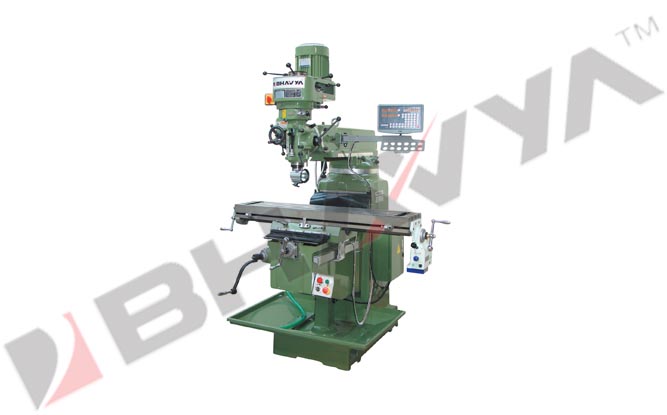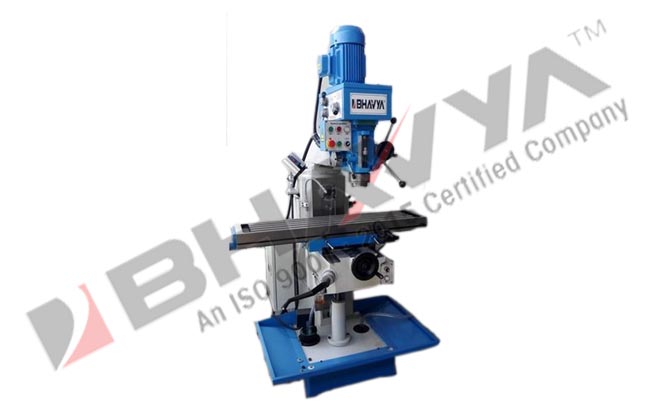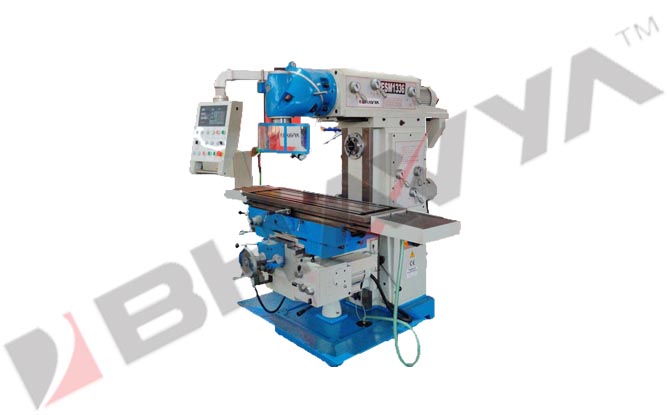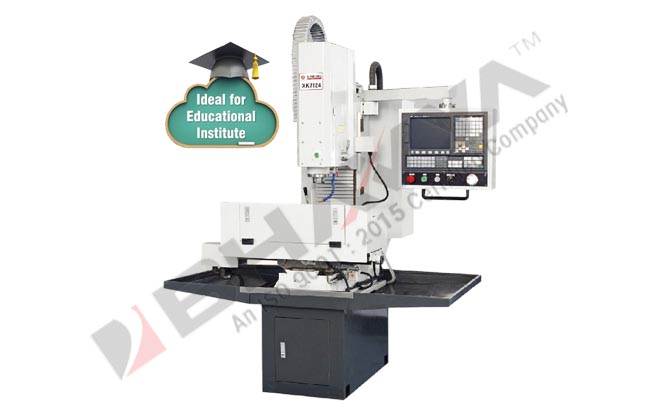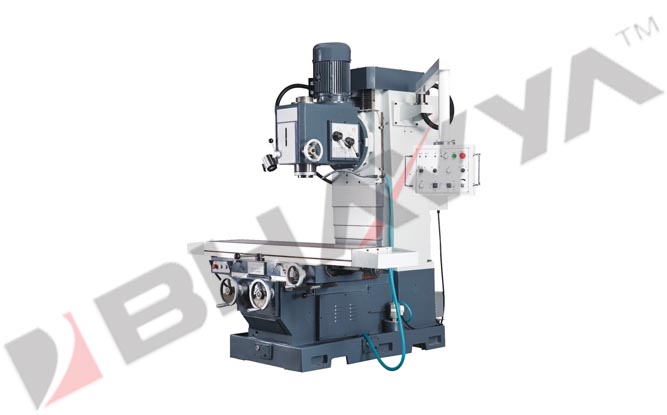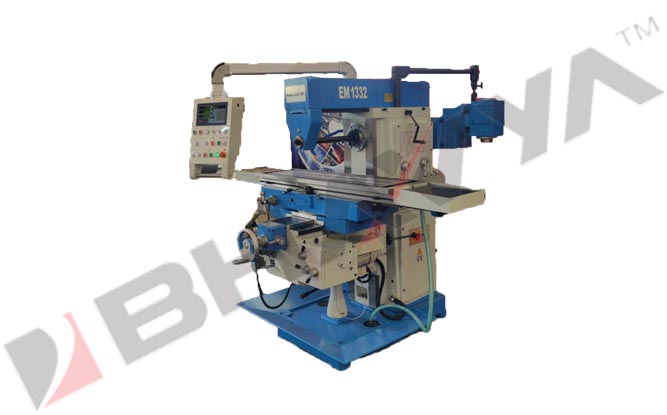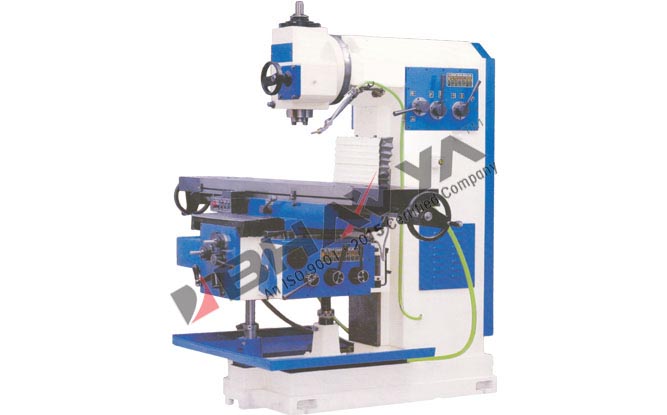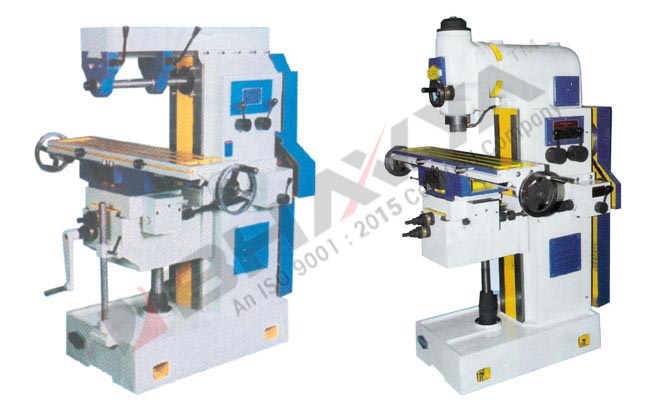Milling Machine
Milling Machine
This type of tool is used for precision shaping of metal and solid materials. We offer various types of tools to mill including manual, mechanical equipment and CNC equipment, keyway machine and dro milling machine. We cater these milling equipments in various models based on factors like table surface, cross, vertical traverse, longitudinal traverse etc. We provide various tools for milling like universal all geared device, vertical all geared, universal geared drive device, keyway milling machine, dro milling machine and accessories. Milling machine is mostly preferred for shaping the surfaces that are flat but irregular in shape. keyway milling machine comprises of a revolving cutter that removes the metal from the billet to obtain the workpiece of desired shape and dimension.
All Geared Universal Milling Machine
Bhavya Machine Tools provides various types of milling machines such as geared universal milling machine, keyway machines, dro milling machine, Knee Type Milling Machine, M1TR Milling Machine, Vertical Knee Type Milling Machine, Column Type Milling Machine, Bed Type Milling Machine, Horizontal Milling Machine, Ram Turret Milling, Vertical Ram Type Milling Machine, Column and Knee Type Milling Machine, Universal Knee Type Milling Machine. A tool is used to precisely shape metal and other solid materials. The all geared universal milling machine has the ability to be operated manually or digitally using automated CNC milling tools. As the machine has very high cutting speed, it is able to generate high output rate.
All Geared Vertical Milling Machine
Bhavya Machine Tools holds expertise in supplying all geared vertical milling machine, keyway milling machines, DRO milling macine, Knee Type Milling Machine, M1TR Milling Machine, Vertical Knee Type Milling Machine, Column Type Milling Machine, Bed Type Milling Machine, Horizontal Milling Machine, Ram Turret Milling, Vertical Ram Type Milling Machine, Column and Knee Type Milling Machine, Universal Knee Type Milling Machine that are widely appreciated for its high performance, rigid construction. Adding to that, the maintenance cost of all geared vertical milling machine is very low and ensures high safety throughout its operation. The machine allows for milling of horizontal, groovy, helical, fissure, and angular surfaces.
Universal Milling Machine
Bhavya Machine Tools provides various types of milling machines such as universal milling machine, keyway milling machine, DRO milling machines, Knee Type Milling Machine, M1TR Milling Machine, Vertical Knee Type Milling Machine, Column Type Milling Machine, Bed Type Milling Machine, Horizontal Milling Machine, Ram Turret Milling, Vertical Ram Type Milling Machine, Column and Knee Type Milling Machine, Universal Knee Type Milling Machine. A tool is used to precisely shape metal and other solid materials. Universal milling machine is precisely used for handling surfaces that are part of a large scale production. It can be bifurcated into horizontal and vertical milling machine.
Vertical Turret Milling Machine
Bhavya Machine Tools provides different types of keyway machine, milling machines such as vertical turret milling machine. This tool is useful for accurately shaping metal and many solid materials. We supply manually operated, mechanically automated and digitally automated CNC milling instruments. Multi-axis machining is possible with the vertical turret milling machine in different operational modes including manually, mechanically, and digitally operated that makes it an absolute versatile piece of machinery. Its ergonomic design makes it highly stable. Get wide range of Knee Type Milling Machine, M1TR Milling Machine, Vertical Knee Type Milling Machine, Column Type Milling Machine, Bed Type Milling Machine, Horizontal Milling Machine, Ram Turret Milling, Vertical Ram Type Milling Machine, Column and Knee Type Milling Machine, Universal Knee Type Milling Machine.
Milling Machine Accessories
Vertical Knee Type Milling Machine
The milling machine i.e. vertical knee type milling machine has its own unique specification like it consist of a saddle where the vertically adjustable worktable is been supported. The knee of this type of milling machine is been operated vertically where the milling spindle & milling head are been adjusted accordingly in the way it is been operated. This knee type milling machine is been specially designed for processing of small to medium sized workpieces. It consists of powerful milling spindle & flexible CNC. Our knee type milling machine will help you meet your needs with high spindle speeds & holder.
As known a milling machine is most known for precision due to which a multiple number of options are available in the market to offer customers a wide number of choices. The most important and known features of the machines are mentioned. A keyway milling machine is used for shaft keyways and are faster than many other milling machines. These DRO millings are famous for their “Digital Read Out” feature. The DRO milling machine is a 3-axis milling machine and provide DRO for X & Y positions of the mill. The DRO grinding machine as name suggests is used for grinding purpose. The M1TR milling machine is known for its low maintenance. A vertical knee type milling machine provides convenience to it users due to the adjustable worktable present in it. The column type milling machine is mainly made up of cast iron body and is suitable for sturdy performance. Since the sliding table is mounted onto the big platform of the machine it also known as bed type milling machine or a column and knee type milling machine. Another variety in the category of vertical milling machine is a vertical ram type milling machine. These universal knee type milling machines are most used for large batch production purposes.
WHAT IS A DRO MILLING MACHINE?
A DRO milling is also known as a DRO grinding machine which is utilized for grinding & milling process. The DRO milling machine is a milling machine with 3-axis in order to provide DRO to both the X & Y points of the mill. The DRO machine is beneficial for its low maintenance. The DRO milling machine offers various convincing facilities to the users. The DRO grinding machines are built from the iron body, which is completely suitable for the strong enforcement of the machine. This universal type milling machine is mostly used for large batch production purposes in different milling industries.
GENERAL FEATURES OF M1TR MILLING MACHINE
M1TR milling machines are also known as Turret mills. M1TR milling is occupied with various tools like a stationary spindle and the table which moves both perpendicularly and in correspondence to the shaft axis to execute the cutting process. The main feature of the machine is that quill allows the milling blades to fluctuate similarly like a drill machine. One of the important features is that this type of machine implements two processes of cutting. An important feature which makes the machines considerable for the industries is that they are extensively used for tasks like changing of tools, spindle RPM change and precise positioning of X & Y coordinates by using DRO. The features of the machine are easy to execute, which makes the machine very reliable. Hence, different operations like drilling, boring and jig boring can be executed by using the M1TR milling machine.
INDUSTRIAL APPLICATIONS OF DRO MILLING MACHINE
The Industrial application of the DRO milling machines is mainly used for shaping and cutting solid items like metal, wood and other metals. The DRO machines are quite different from a lathe, as the tool head present in the machine rotates rapidly. This knee type milling machine is set up with digital reading technology which is useful in factories to measure the work executed by the machine in a single day. The DRO system allows the machine parts to be managed on a high level of complexity with engraved elements present in the machine. The DRO millers also execute different processes like fine cutting and shaping of materials according to the requirement of the user or the industry. One of the industrial applications of the machine is that the DRO milling machines auto-detects the portion of the material which has to be cut down for proper shaping.
GLOBAL DEMAND OF KEYWAY MILLING MACHINE
The global demand for keyway milling machines are high in countries like the USA, where different industrial equipment requires cutting and shaping of materials. In keyway millers, the key is a part that is utilized in an automatic device to execute processes like the circumferential fixation within the beams and the parts on the bar. The keyway milling machine has a global demand because the keyway millers offer the finest cutting, which is a preferable option by the industries globally. In countries like the USA, India and Japan, the demand is quite high because various types of materials manufactured in the country require the keyway milling process for the finest cutting and shaping of the material.
The use of the DRO millers can be seen in different industries globally, as every material processing industry requires a fine cut down material/metal to build up different types of machinery used in the factories. As there are different processes of DRO milling machines, here are various points that will explain everything to know about the DRO milling machines.
The Different Types of Milling Machines and Their Working Benefits
The size and durability of the milling machine give large support to handle heavy machines without damaging themselves. By reducing the chances of human error it assures accurate cuts. The vertical milling machine has a vertically oriented tool whereas the horizontal milling machine has a horizontal oriented tool and both have the capability of producing complicated shapes, using multi-tooth and single point cutting tools and great precision in the finishing of work. The bed milling machine is another type of variant of the vertical milling machine but with a pendant with easier access of the cutting tool to the work piece. These milling machines and their advantages are related to the particular designs and materials being machined. Another machine is the DRO milling one which has a 3 axis and is a universal milling machine is used for large production batches in different milling industries. The keyway milling machine is modern equipment where the depth of the cut can be programmable. These are faster in operation and available in different specifications. Similarly, the Column and Knee Type Milling machines are advisable to be used where there are smaller work pieces and very few shop floors. This way the work pieces can be supported on the knee. The column-type milling machine is also mounted on the knee and designed to move up and down accurately. The various types of milling machines offer versatility and aid in positioning and checking operations seamlessly.
We take pride in providing the Milling Machine products that are efficient and customized. We have worked with several clients in a wide range of industries.
And all over the world, including in India, Kuwait, Bahrain, Iraq, Qatar, Oman, United Arab Emirates, Saudi Arabia, Dubai, Yemen, Bhavya Machine Tools offers the greatest quality Milling Machines at the best prices.
FAQs
A milling machine is a powerful and versatile machine tool used for machining solid materials. It has a rotary cutter that removes material from a workpiece, advancing it against a rotating cutter. The cutter may be a multipoint cutting tool or a single-point tool, and it is guided along different axes to create precise shapes, slots, holes, and other features in the workpiece. Milling machines are commonly used in metalworking, but they can also be used for cutting and shaping a variety of materials, including plastics and composites. There are various types of milling machines, such as vertical milling machines, horizontal milling machines, and CNC milling machines, each with its own specific advantages and applications.
There are several types of milling machines, each designed for specific purposes. Here are some common types:
Vertical Milling Machine: The spindle in a vertical milling machine is positioned vertically. This type is suitable for end milling operations.
Horizontal Milling Machine: In a horizontal milling machine, the spindle is placed horizontally. It is often used for side milling and face milling.
Universal Milling Machine: A universal milling machine has the ability to swivel the cutter horizontally or vertically, making it versatile for various milling tasks.
Bed Type Milling Machine: This type of milling machine has a worktable that can be moved along different axes. It is known for its sturdiness and rigid construction.
Knee-Type Milling Machine: Knee-type milling machines have a vertically adjustable worktable supported by a knee, which can be adjusted up or down.
CNC Milling Machine: CNC (Computer Numerical Control) milling machines are automated milling machines controlled by a computer. They offer high precision and are capable of complex machining tasks.
Planer-Type Milling Machine: Planer-type milling machines have a large worktable and are used for heavy-duty tasks. The milling head is mounted on a cross rail for vertical adjustment.
Ram-Type Milling Machine: In a ram-type milling machine, the milling head is mounted on a sliding ram. This allows the spindle to be adjusted and extended to different positions.
Gantry Type Milling Machine: Gantry milling machines have a bridge-like structure with two columns supporting the horizontal spindle. They are often used for large workpieces.
Mini Milling Machine: Mini milling machines are smaller, more compact versions designed for hobbyists, small workshops, or educational purposes.
The primary difference between vertical and horizontal milling machines lies in the orientation of the spindle axis and the worktable.
Vertical Milling Machine:
- Spindle axis is vertically oriented.
- Cutter or drill is attached to the spindle, moving up and down to remove material.
- Ideal for end milling operations and smaller workpieces.
Horizontal Milling Machine:
- Spindle axis is horizontally oriented.
- Cutter or drill is mounted on a horizontal arbor, moving side to side to remove material.
- Suitable for side milling, face milling, and larger workpieces.
In essence, it's about the direction of the cutting forces and the type of operations each machine is best suited for.
CNC milling refers to the process of using computer numerical control (CNC) to automate the operation of a milling machine. In traditional milling, a machinist manually controls the milling machine, but in CNC milling, a computer program controls the movement and operation of the machine.
Here's a brief overview of CNC milling:
Computer Programming: A computer program, often created with CAD (Computer-Aided Design) software, defines the toolpaths and operations needed to machine a specific part.
CNC Controller: The program is loaded into a CNC controller, which interprets the instructions and converts them into electrical signals to control the movement of the milling machine.
Automated Operation: The CNC milling machine's axes (X, Y, and Z) and the spindle are controlled automatically, following the programmed toolpaths with precision.
Tool Changes: CNC milling machines can automatically change cutting tools during the machining process, allowing for a variety of operations without manual intervention.
High Precision: CNC milling provides high precision and repeatability, making it ideal for complex and intricate parts.
Versatility: CNC milling machines can perform a wide range of milling operations, including contour milling, drilling, tapping, and 3D machining.
Time Efficiency: CNC milling is generally faster and more efficient than manual milling, especially for large production runs.
Quality Control: CNC milling allows for consistent and accurate production, reducing the likelihood of errors associated with manual operation.
CNC milling is widely used in various industries, including manufacturing, aerospace, automotive, and prototyping, due to its ability to produce precise and complex parts with efficiency and accuracy.
Milling machines are versatile and can be used to machine a wide range of materials. Some common materials that can be milled with a milling machine include:
Metals:
- Aluminum
- Steel
- Stainless steel
- Brass
- Copper
- Titanium
- Cast iron
Plastics:
- Acrylic
- PVC
- Nylon
- Polycarbonate
- Delrin (Acetal)
- HDPE (High-Density Polyethylene)
Composites:
- Carbon fiber composites
- Fiberglass composites
Wood:
- Hardwoods (e.g., oak, maple)
- Softwoods (e.g., pine, cedar)
Foam:
- Polyurethane foam
- Polystyrene foam
Ceramics:
- Certain ceramics can be milled, although specialized milling machines and tools are often required.
It's important to note that the choice of cutting tools and milling parameters may vary based on the material being machined. Additionally, some materials may pose challenges due to their hardness, abrasiveness, or other characteristics, requiring specific milling techniques and tooling. Always consider the material properties and select appropriate tools and cutting speeds for the best results.
A milling cutter is a rotary cutting tool used in milling machines to remove material from a workpiece. It has multiple cutting edges, known as teeth, that work together to perform various milling operations. Milling cutters come in a variety of shapes and sizes, each designed for specific types of cutting tasks. Here are some common types of milling cutters:
End Mill: Used for peripheral or contour milling, slotting, and face milling. It has cutting edges on the end and the sides.
Face Mill: Designed for facing and shoulder milling. It has cutting edges on the periphery and the face.
Ball Mill: Features a ball-shaped cutter for 3D contour milling or specialized finishing operations.
Slot Drill: Similar to an end mill but with a cutting edge extending to the center. Used for slotting and profiling.
Fly Cutter: A single-point cutter used for facing large flat surfaces.
T-slot Cutter: Specifically designed for cutting T-slots in machine tables.
Shell Mill: Large-diameter cutter with multiple inserts for high-speed machining and heavy cuts.
Keyseat Cutter: Used for cutting keyways in shafts.
Woodruff Cutter: Specialized cutter for milling keyways for Woodruff keys.
Dovetail Cutter: Used for machining dovetail slots.
These cutters are mounted on the milling machine's spindle and rotate at high speeds to cut into the workpiece. The choice of milling cutter depends on the type of operation, the material being machined, and the desired outcome.
A milling machine vise is used to hold the workpiece securely in place during the milling process. It ensures stability and accuracy in machining.
A milling machine works by using a rotating cutter to remove material from a stationary workpiece. Here's a brief overview of how it works:
Clamping the Workpiece: The workpiece is securely clamped to the milling machine table using a milling vise or other clamping mechanisms.
Setting the Cutter: A milling cutter, such as an end mill or face mill, is mounted on the milling machine spindle. The cutter's position and depth are set based on the desired machining operation.
Selecting Speed and Feed: The milling machine's speed and feed rates are selected based on the material being machined and the type of cutter used. This ensures optimal cutting conditions.
Initiating the Cut: The milling machine is turned on, and the cutter is brought into contact with the workpiece. The cutter's rotation, combined with the movement of the workpiece or the milling machine table, removes material.
Controlling Cutter Movement: The milling machine's table can be moved in multiple directions (X, Y, and Z axes) to control the cutter's path and create the desired shape on the workpiece.
Creating Features: As the cutter moves across the workpiece, it creates features such as slots, pockets, contours, or other shapes, depending on the programmed toolpaths.
Adjusting Parameters: Machinists may adjust the milling machine's parameters, such as depth of cut and cutting speed, to achieve the desired finish and accuracy.
Removing Material Incrementally: Material is removed incrementally, with the milling machine making multiple passes until the final dimensions and surface finish are achieved.
Completing the Operation: Once the milling operation is complete, the milling machine can be turned off, and the machined workpiece is unclamped from the table.
In essence, a milling machine removes material from a workpiece using a rotating cutter, and the movement of the cutter and workpiece is controlled to achieve precise and accurate machining. The versatility of milling machines allows for a wide range of operations and the creation of intricate parts with different shapes and features.
Yes, milling machines can indeed be used for 3D machining. Using Computer-Aided Design (CAD) and Computer-Aided Manufacturing (CAM) software, milling machines can follow complex toolpaths in three dimensions to create intricate and detailed three-dimensional shapes on a workpiece. The CNC (Computer Numerical Control) system of the milling machine precisely controls the movement of the milling cutter along the X, Y, and Z axes to achieve the desired 3D geometry.
When using a milling machine, it's crucial to prioritize safety. Here are some key safety precautions:
Personal Protective Equipment (PPE): Wear appropriate PPE, including safety glasses, hearing protection, and, if necessary, gloves. Avoid loose clothing and tie back long hair.
Training: Ensure that operators are properly trained in the use of milling machines. Familiarize yourself with the machine's controls and emergency shutdown procedures.
Machine Inspection: Before operation, inspect the milling machine for any damage, loose parts, or potential issues. Ensure that all safety guards are in place and functioning.
Securing Workpiece: Securely clamp the workpiece in the milling machine vise or using other appropriate clamping methods to prevent it from moving during machining.
Tool Inspection: Inspect milling cutters for damage or wear before use. Use the correct tool for the specific operation, and ensure it is securely mounted.
Work Area Cleanliness: Keep the work area clean and free of clutter. Remove chips and debris regularly to prevent them from interfering with the machining process.
Speeds and Feeds: Follow recommended speeds and feeds for the specific material and cutter being used. Operating at incorrect speeds can lead to tool breakage or other issues.
Toolpath Planning: Plan toolpaths carefully to avoid sudden and unexpected movements. Be aware of the cutter's position in relation to the workpiece at all times.
Emergency Stop: Know the location of the emergency stop button and how to use it. In case of any unexpected issues, be prepared to stop the machine immediately.
Eye Protection: Always wear safety glasses or goggles to protect your eyes from flying chips and debris.
Communication: If working in a team, communicate effectively. Ensure everyone is aware of the machining process and potential hazards.
Dust and Fume Extraction: If milling materials that produce dust or fumes, use appropriate extraction systems to maintain air quality.
Safe Handling of Materials: Use proper lifting techniques when handling heavy materials or tools to prevent injuries.
Lockout/Tagout Procedures: Follow lockout/tagout procedures when performing maintenance or repairs on the milling machine to prevent accidental startup.
By following these safety precautions, operators can minimize the risks associated with using milling machines and create a safer working environment.
This customized website concept / text and images are our intellectual property, any company or individual copy whole or a part of the concept is liable to face legal consequences as per the Jurisdiction of Ahmedabad, India.
Copyright© 2024, Bhavya Machine Tools, All rights Reserved
Website Design & Digital Marketing by Opal Infotech


